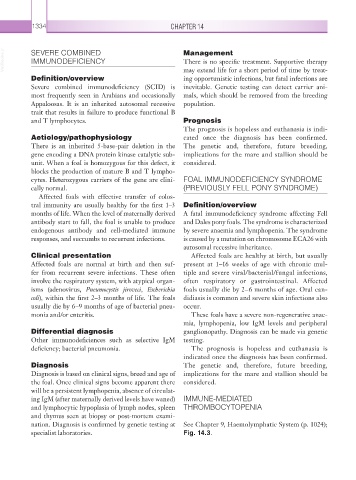Page 1359 - Equine Clinical Medicine, Surgery and Reproduction, 2nd Edition
P. 1359
1334 CHAPTER 14
VetBooks.ir SEVERE COMBINED Management
IMMUNODEFICIENCY
There is no specific treatment. Supportive therapy
Definition/overview may extend life for a short period of time by treat-
ing opportunistic infections, but fatal infections are
Severe combined immunodeficiency (SCID) is inevitable. Genetic testing can detect carrier ani-
most frequently seen in Arabians and occasionally mals, which should be removed from the breeding
Appaloosas. It is an inherited autosomal recessive population.
trait that results in failure to produce functional B
and T lymphocytes. Prognosis
The prognosis is hopeless and euthanasia is indi-
Aetiology/pathophysiology cated once the diagnosis has been confirmed.
There is an inherited 5-base-pair deletion in the The genetic and, therefore, future breeding,
gene encoding a DNA protein kinase catalytic sub- implications for the mare and stallion should be
unit. When a foal is homozygous for this defect, it considered.
blocks the production of mature B and T lympho-
cytes. Heterozygous carriers of the gene are clini- FOAL IMMUNODEFICIENCY SYNDROME
cally normal. (PREVIOUSLY FELL PONY SYNDROME)
Affected foals with effective transfer of colos-
tral immunity are usually healthy for the first 1–3 Definition/overview
months of life. When the level of maternally derived A fatal immunodeficiency syndrome affecting Fell
antibody start to fall, the foal is unable to produce and Dales pony foals. The syndrome is characterized
endogenous antibody and cell-mediated immune by severe anaemia and lymphopenia. The syndrome
responses, and succumbs to recurrent infections. is caused by a mutation on chromosome ECA26 with
autosomal recessive inheritance.
Clinical presentation Affected foals are healthy at birth, but usually
Affected foals are normal at birth and then suf- present at 1–16 weeks of age with chronic mul-
fer from recurrent severe infections. These often tiple and severe viral/bacterial/fungal infections,
involve the respiratory system, with atypical organ- often respiratory or gastrointestinal. Affected
isms (adenovirus, Pneumocystis jiroveci, Escherichia foals usually die by 2–6 months of age. Oral can-
coli), within the first 2–3 months of life. The foals didiasis is common and severe skin infections also
usually die by 6–9 months of age of bacterial pneu- occur.
monia and/or enteritis. These foals have a severe non-regenerative anae-
mia, lymphopenia, low IgM levels and peripheral
Differential diagnosis ganglionopathy. Diagnosis can be made via genetic
Other immunodeficiences such as selective IgM testing.
deficiency; bacterial pneumonia. The prognosis is hopeless and euthanasia is
indicated once the diagnosis has been confirmed.
Diagnosis The genetic and, therefore, future breeding,
Diagnosis is based on clinical signs, breed and age of implications for the mare and stallion should be
the foal. Once clinical signs become apparent there considered.
will be a persistent lymphopenia, absence of circulat-
ing IgM (after maternally derived levels have waned) IMMUNE-MEDIATED
and lymphocytic hypoplasia of lymph nodes, spleen THROMBOCYTOPENIA
and thymus seen at biopsy or post-mortem exami-
nation. Diagnosis is confirmed by genetic testing at See Chapter 9, Haemolymphatic System (p. 1024);
specialist laboratories. Fig. 14.3.

